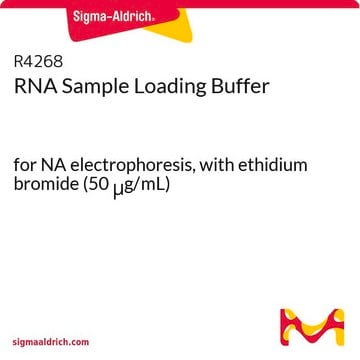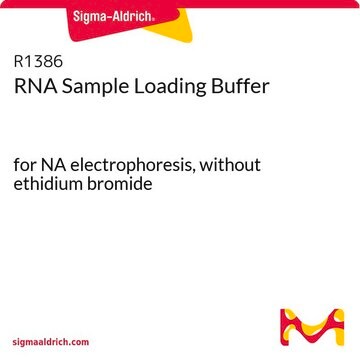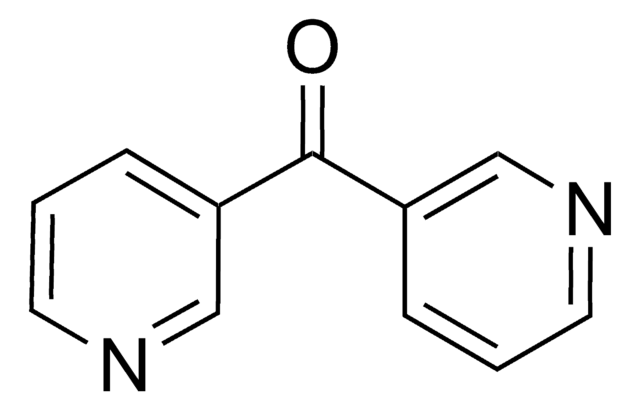G7654
Gel Loading Solution
for NA electrophoresis, solution
Sinonimo/i:
DNA Gel Loading Solution, Gel Loading Buffer
Autenticatiper visualizzare i prezzi riservati alla tua organizzazione & contrattuali
About This Item
Codice UNSPSC:
12161703
NACRES:
NA.25
Prodotti consigliati
Grado
for molecular biology
Livello qualitativo
Forma fisica
solution
Concentrazione
6 ×
Temperatura di conservazione
2-8°C
Descrizione generale
Gel loading solution is used as a tracking dye during electrophoresis. The dyes have a slight negative charge and will migrate the same direction as DNA, allowing the user to monitor the progress of molecules moving through the gel. The rate of migration varies with gel composition. Dilute 1:6 with sample before loading.
Applicazioni
Suitable for use with agarose or non-denaturing polyacrylamide gel electrophoresis (PAGE), which may be part of Northern and Southern blot hybridization procedures.
Componenti
Gel loading buffer contains 0.25% bromophenol blue, 0.25% xylene cyanol, and 40% sucrose.
Altre note
Band migration can be expected as follows:
On polyacrylamide gels, xylene cyanole comigrates with approximately 450-460 bp DNA, while bromophenol blue comigrates with 15-100 bp DNA. On 0.5 – 1.4% agarose gels, xylene cyanole comigrates with 4 kb dsDNA, while bromophenol blue comigrates with 300 bp dsDNA.
On polyacrylamide gels, xylene cyanole comigrates with approximately 450-460 bp DNA, while bromophenol blue comigrates with 15-100 bp DNA. On 0.5 – 1.4% agarose gels, xylene cyanole comigrates with 4 kb dsDNA, while bromophenol blue comigrates with 300 bp dsDNA.
Prodotti correlati
N° Catalogo
Descrizione
Determinazione del prezzo
Codice della classe di stoccaggio
12 - Non Combustible Liquids
Classe di pericolosità dell'acqua (WGK)
WGK 2
Punto d’infiammabilità (°F)
Not applicable
Punto d’infiammabilità (°C)
Not applicable
Certificati d'analisi (COA)
Cerca il Certificati d'analisi (COA) digitando il numero di lotto/batch corrispondente. I numeri di lotto o di batch sono stampati sull'etichetta dei prodotti dopo la parola ‘Lotto’ o ‘Batch’.
Possiedi già questo prodotto?
I documenti relativi ai prodotti acquistati recentemente sono disponibili nell’Archivio dei documenti.
I clienti hanno visto anche
Sambrook, J., et al.
Molecular Cloning: A Laboratory Manual, 6-6 (1989)
David R Macinga et al.
Antimicrobial agents and chemotherapy, 47(8), 2526-2537 (2003-07-25)
We have characterized an early series of 5,6-bridged dioxinoquinolones which behaved strikingly different from typical quinolones. The 5,6-bridged dioxinoquinolones inhibited Escherichia coli DNA gyrase supercoiling activity but, unlike typical quinolones, failed to stimulate gyrase-dependent cleavable complex formation. Analogous unsubstituted compounds
S Henry et al.
Vox sanguinis, 70(1), 21-25 (1996-01-01)
While screening Le(a+b+)Polynesian DNA samples for a candidate Se(w) allele, a point mutation (C571-->T) resulting in a new stop codon (Arg191-->stop) in the alpha(1,2)fucosyltransferase gene (FUT2) was identified. This point mutation resulted in the gaining of a new restriction enzyme
M K Bolla et al.
Journal of lipid research, 40(12), 2340-2345 (1999-12-10)
The apoE gene exhibits two common polymorphisms that have been associated with both coronary artery disease and Alzheimer's disease. The polymorphisms create the three allelic isoforms E2, E3, and E4 which are encoded by Cys;-Cys, Cys;-Arg, and Arg;-Arg at amino
Peter Konings et al.
Nature protocols, 7(2), 281-310 (2012-01-21)
We present a protocol for reliably detecting DNA copy number aberrations in a single human cell. Multiple displacement-amplified DNAs of a cell are hybridized to a 3,000-bacterial artificial chromosome (BAC) array and to an Affymetrix 250,000 (250K)-SNP array. Subsequent copy
Il team dei nostri ricercatori vanta grande esperienza in tutte le aree della ricerca quali Life Science, scienza dei materiali, sintesi chimica, cromatografia, discipline analitiche, ecc..
Contatta l'Assistenza Tecnica.












